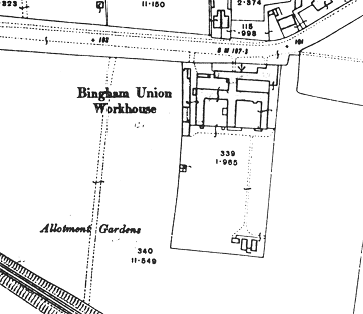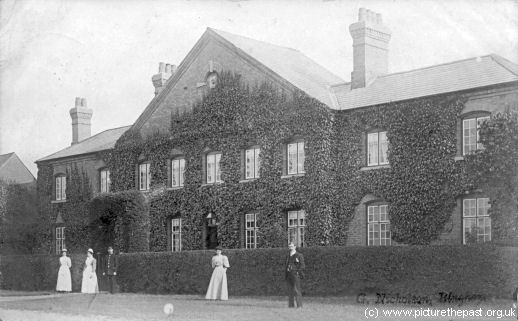Bingham, Nottinghamshire
Up to 1834
A parliamentary report of 1777 recorded a parish workhouse in operation at Bingham with accommodation for up to 30 inmates.
Bingham was one of several poor law incorporations formed in Nottinghamshire under the terms of Gilbert's Act of 1782. Others included Gedling (1787), Claypole (1817), East Retford (1818), Thurgarton (1824), Bingham, Blyth, and Clarborough.
Bingham was notable as being the home of the Revd Robert Lowe who, as Rector of the parish, was one of the influential reformers in the field of poor relief administration in the early part of the nineteenth century. The unemployed labourers in Bingham, who in 1818 numbered 181, had been described as idle, mischievous and profuse (Caplan, 1984). Lowe withdrew all monetary relief to the able-bodied and instead offered them only the workhouse which provided shelter and food, but under a regime of strict discipline and restraint. The result was that poor relief expenditure in Bingham fell from over £1,200 in 1816-18 to £367 in 1822. The success of Lowe's scheme was repeated at Southwell where his cousin, the Revd JT Becher, was minister. Becher also adopted the same approach with the new Thurgarton Hundred Incorporation formed in 1824. The ideas developed by Lowe and Becher undoubtedly influenced the form of the 1834 Poor Law Amendment Act.
In 1828, Pigot's Directory records that the Bingham workhouse stood on Moor Lane, with Edward Dean as its governor.
After 1834
The Bingham Incorporation was, in principle, immune from the strictures of the 1834 Act. However, its Guardians were persuaded that the Incorporation should be dissolved and replaced by a new Poor Law Union. The Bingham Poor Law Union formally came into being on 1st July 1836. Its operation was overseen by an elected Board of Guardians, 41 in number, representing its 40 constituent parishes as listed below (figures in brackets indicate numbers of Guardians if more than one):
County of Nottingham:
Aslockton, Barnston-cum-Langar [Barnstone cum Langar], Bingham (2), Car Colston, Clipston, Colston Bassett, Cotgrave, Cropwell Bishop, Cropwell Butler, East Bridgeford [Bridgford], Edwalton, Elton, Flawborough, Flintham, Granby, Hawksworth, Hickling, Holme Pierpoint [Pierrepont], Keyworth, Kinoulton, Kneeton, Normanton-on-the-Wolds, Orston, Owthorpe, Plumtree, Radcliffe-on-Trent, Saxondale, Scarrington, Screveton, Shelford, Shelton, Sibthorpe, Stanton on the Wolds, Tithby, Thoroton, Tollerton, Whatton, Widmerpool.
County of Leicester
Barkston, Plungar.
Later Additions: Lodge on the Wolds (1858-96), Wiverton Hall (from 1858).
The population falling within the Union at the 1831 census had been 14,773 — with parishes ranging in size from from Flawborough (population 80) to Bingham itself (1,738). The average annual poor-rate expenditure for the period 1833-35 had been £4,432 or 6s.0d. per head.
A new Bingham Union workhouse for 200 inmates was erected in 1836-37, with the old workhouse being kept in use until its completion. The two-acre site on the south side of the Nottingham Road "at the top end of town" was bought from Lord Chesterfield at £150 per acre. The architect of the new building was Henry J Stevens although his design was based on the model "200-pauper" plan published by the Poor Law Commissioners in 1836. The final cost of the building was £3,160. The site location and layout are shown on the 1914 map below.

Bingham workhouse site, 1914.
Below is an early 1900s view of the building with the workhouse staff posed in front.

Bingham workhouse from the north-west, early 1900s. © A.P. Knighton and www.picturethepast.org.uk.
After 1930, the workhouse became the Bingham Public Assistance Institution. It was in use as a home for the aged and infirm until its closure in 1965. The building was demolished in 1967.
Children's Home
The Bingham Union established a children's home at Union Street, Bingham. In 1908, it could house 11 children and Florence R Hart was the home's Industrial Trainer. By 1911, the home had moved to Fairfield Street, Bingham. In 1924, the home could house up to 13 children, with E.E. Hall now as the Industrial Trainer.
Staff
Inmates
Records
Note: many repositories impose a closure period of up to 100 years for records identifying individuals. Before travelling a long distance, always check that the records you want to consult will be available.
- Nottinghamshire Archives and Southwell Diocesan Record Office, County House, Castle Meadow Road, Nottingham NG2 1AG. Relatively few records survive — holdings include: Guardians' minute books (1836-1930); Births (1837-1930); etc.
Bibliography
- In the Shadow of the Workhouse by Maurice Caplan (1984)
- Radcliffe-on-Trent 1837 to 1920 edited by Pamela Priestland (1989).
Links
- None.
Acknowledgment
- Archive picture is by kind permission of www.picturethepast.org.uk and A.P. Knighton.
Unless otherwise indicated, this page () is copyright Peter Higginbotham. Contents may not be reproduced without permission.


